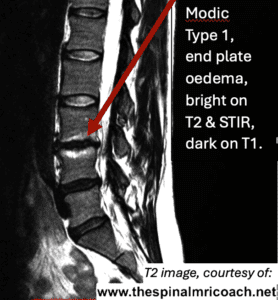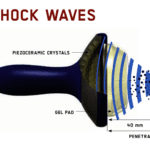Clinical Guidance Note: Modic Type 1 Changes and IDD Therapy
- Modic Type I Changes on MRI
Modic changes are alterations in the vertebral bone marrow observed on magnetic resonance imaging (MRI). Modic Type I changes specifically refer to regions of decreased signal intensity (dark) on T1-weighted images and increased signal intensity (bright) on T2-weighted images. With regards to T2 images, fat also produces hyperintensity, so a bright signal in the vertebra either side of a disc indicates either water or fat, and so, such a finding on it’s own might
Indicate Modic type 2 (i.e. fatty marrow). Furthermore it is possible to have a transition Modic change i.e. a mixture of water and fat in the vertebral bone marrow. Therefore a fat suppression sequences such as a STIR is the best type of sequence to highlight the presence of Modic type 1.

Summary of Bone Marrow Changes seen in Modic Type 1:
Dark: on T1
Bright: on T2
Bright: on STIR
This typically indicates the presence of oedema or inflammation within the vertebral body +/- minute stress factures within the cancellous bone. In the context of disc herniation, Modic Type I changes often manifest adjacent to the affected intervertebral disc and are associated with degeneration of the cartilaginous end plate.
- Causes of Modic Type I Changes
Modic changes are commonly associated with degenerative disc disease and are believed to result from a combination of mechanical, biological and genetic factors. The primary causes include:
- Microbial Infection: Some studies suggest a potential link between Modic Type I changes and low-grade disc infections.
- Inflammatory Response: Inflammation, in associated with end plate damage, possibly triggered by the leakage of disc material into the vertebral body (intravertebral disc protusion), leading to vascular changes and subsequent oedema within the vertebral bone.
- Mechanical Stress: Chronic mechanical stress and instability in the affected spinal segment contributes to the development of disc and end plate degeneration that lead to Modic changes.
- Presence of Modic Type I Changes in Disc Herniation
When a patient presents with a herniated disc, Modic Type I changes may be present due to the inflammatory response associated with disc end plate degeneration. The proximity of the inflammatory changes to the disc herniation suggests a dynamic relationship between disc pathology and vertebral bone alterations.
- IDD Therapy and Considerations for Modic Type I Changes
IDD Therapy, utilizing distraction forces, has shown effectiveness in treating disc herniation. However, when Modic Type I changes are present, a more cautious approach is often warranted.
a. Lighter Forces Initially:
- The use of lighter distraction forces is essential initially to avoid exacerbating pain associated with Modic Type I changes. The inflammatory nature of these changes may make the patient more sensitive to mechanical stresses.
- Gradual progression in force application allows for adaptation and minimises the risk of triggering an undesirable inflammatory response, thereby enhancing patient tolerance.
B. Monitoring Patient Response:
- Regular assessment of the patient’s response to IDD Therapy is crucial. Monitoring for any signs of increased pain, discomfort, or adverse reactions is essential for adjusting the treatment plan accordingly.
- If the patient experiences heightened pain or intolerance, reducing the distraction force or modifying the treatment frequency may be necessary.
c. Multidisciplinary Approach:
- Collaborative communication between the treating clinician, radiologist, and other healthcare providers is vital in managing patients with disc herniation and concomitant Modic Type I changes.
- Consideration of additional modalities, such as anti-inflammatory medications, focussed shockwave or tecar therapy may complement the effects of IDD Therapy in addressing both the disc herniation and the associated Modic changes.
Tension Progression
Where Modic Type 1 changes are present, consider starting tension half body weight minus 30 lbs (HBW-30). Very gradual progression of tensions subject to patient response to treatment.
Conclusion
The presence of Modic Type I changes in patients with disc herniation warrants a tailored approach during IDD Therapy. Careful consideration of the underlying causes and the inflammatory nature of Modic changes is crucial in optimising patient outcomes.
By employing lighter forces initially and closely monitoring patient response, healthcare providers can strike a balance between effective treatment and minimising the risk of exacerbating symptoms. A collaborative, multidisciplinary approach ensures comprehensive care for patients with disc herniation and Modic Type I changes.
Produced in associated with Steadfast incorporated
MRI and editing courtesy of thespinalmricoach.net




